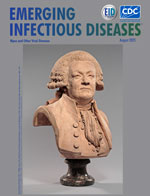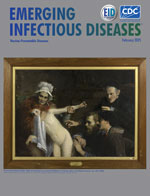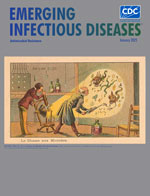Online Reports
Volume 31—2025
Volume 31, Number 12—December 2025

Diphtheria Antitoxin Production and Procurement Practices and Challenges
Treatment of respiratory diphtheria requires prompt administration of equine diphtheria antitoxin (DAT) to neutralize circulating toxin. We conducted surveys of key procurement agencies and manufacturers currently engaged in DAT manufacturing or procurement, along with key informant interviews with developers of monoclonal antibodies. Our findings indicate that prices and availability of DAT vary and that prediction of demand is challenging for both manufacturers and procurement agencies. Substantial concerns were raised over the inability to obtain enough DAT to respond to increasing global outbreaks. Monoclonal antibody developers noted financial challenges in advancing their clinical and manufacturing progress.
| EID | Marshall C, Caro W, Costa A, Ho L, Gardner PJ, Guitton C, et al. Diphtheria Antitoxin Production and Procurement Practices and Challenges. Emerg Infect Dis. 2025;31(12):1-7. https://doi.org/10.3201/eid3112.250796 |
|---|---|
| AMA | Marshall C, Caro W, Costa A, et al. Diphtheria Antitoxin Production and Procurement Practices and Challenges. Emerging Infectious Diseases. 2025;31(12):1-7. doi:10.3201/eid3112.250796. |
| APA | Marshall, C., Caro, W., Costa, A., Ho, L., Gardner, P. J., Guitton, C....Sparrow, E. (2025). Diphtheria Antitoxin Production and Procurement Practices and Challenges. Emerging Infectious Diseases, 31(12), 1-7. https://doi.org/10.3201/eid3112.250796. |
Volume 31, Number 8—August 2025

Optimal Timing for Expanding Diagnostic Laboratories, South Korea
The rapid expansion of testing capacity is imperative for an adequate response to infectious diseases, such as COVID-19. South Korea rapidly secured large-scale testing during the early stages of COVID-19 in 2020 by leveraging the country’s experience with the 2015 Middle East respiratory syndrome outbreak; the initial response was relatively successful. A key difference between the 2 outbreak responses was the expansion from public to private testing laboratories during the COVID-19 pandemic. Expanding testing capacity during an infectious disease crisis should involve consideration of the overall response system and social conditions and not just the number of patients. If there are concerns about a crisis developing, testing capacity expansion should begin as soon as possible. Furthermore, accuracy should be ensured, especially when testing capacity is expanded. South Korea’s experience in developing diagnostic systems and adopting testing strategies underscores the value of proactive and well-timed preparedness for emerging infection disease outbreaks.
| EID | Park J, Kim G, Lee S. Optimal Timing for Expanding Diagnostic Laboratories, South Korea. Emerg Infect Dis. 2025;31(8):1-8. https://doi.org/10.3201/eid3108.241745 |
|---|---|
| AMA | Park J, Kim G, Lee S. Optimal Timing for Expanding Diagnostic Laboratories, South Korea. Emerging Infectious Diseases. 2025;31(8):1-8. doi:10.3201/eid3108.241745. |
| APA | Park, J., Kim, G., & Lee, S. (2025). Optimal Timing for Expanding Diagnostic Laboratories, South Korea. Emerging Infectious Diseases, 31(8), 1-8. https://doi.org/10.3201/eid3108.241745. |
Volume 31, Number 3—March 2025

Lessons Learned from Early Implementation and Scale-up of Stool-Based Xpert Testing to Diagnose Tuberculosis in Children
In 2020, fecal (stool) testing was recommended for diagnosing Mycobacterium tuberculosis complex (MTBC) infection in children by using the Cepheid Xpert MTB/RIF assay; since then, countries have begun implementing stool-based testing, often as part of a comprehensive strategy to enhance TB case finding among children. On the basis of an experience-sharing workshop in November 2023, we determined insights of 9 early-adopter countries. Across those countries, 71,757 children underwent stool testing over a combined period of 121 months, October 2020–September 2023. A total of 2,892 children were positive for MTBC, and rifampin resistance was confirmed for 43 stool samples. The overall yield of MTBC detection across the countries was 4.1% (range 1.1%–17.3%). Stool collection for Xpert testing was considered noninvasive and as easy as sputum testing. Stool-based testing can be integrated into peripheral healthcare levels as a routine test to increase bacteriologic confirmation among children with presumptive TB.
| EID | Klinkenberg E, de Haas P, Manyonge C, Namutebi J, Mujangi B, Mutunzi H, et al. Lessons Learned from Early Implementation and Scale-up of Stool-Based Xpert Testing to Diagnose Tuberculosis in Children. Emerg Infect Dis. 2025;31(3):1-9. https://doi.org/10.3201/eid3103.241580 |
|---|---|
| AMA | Klinkenberg E, de Haas P, Manyonge C, et al. Lessons Learned from Early Implementation and Scale-up of Stool-Based Xpert Testing to Diagnose Tuberculosis in Children. Emerging Infectious Diseases. 2025;31(3):1-9. doi:10.3201/eid3103.241580. |
| APA | Klinkenberg, E., de Haas, P., Manyonge, C., Namutebi, J., Mujangi, B., Mutunzi, H....Colvin, C. (2025). Lessons Learned from Early Implementation and Scale-up of Stool-Based Xpert Testing to Diagnose Tuberculosis in Children. Emerging Infectious Diseases, 31(3), 1-9. https://doi.org/10.3201/eid3103.241580. |
Volume 31, Number 2—February 2025

Arbovirus Epidemics as Global Health Imperative, Africa, 2023
Arboviruses represent a major cause of illness in Africa and have the potential to trigger widespread epidemics. We present data on arbovirus epidemics in Africa in 2023 and demonstrate the need for global public health authorities to intensify efforts in the surveillance and control of arbovirus diseases. Data were collected from the World Health Organization Weekly Bulletin on Outbreaks and Other Emergencies, Africa Centers for Disease Control and Prevention Weekly Event Based Surveillance Report, and other online sources. In 2023, a total of 7 arboviruses were responsible for 29 outbreaks across 25 countries in Africa, 22 of which occurred in West Africa; the outbreaks resulted in 19,569 confirmed cases and 820 deaths. Arbovirus epidemics in Africa pose a threat not only to public health within the continent but also globally, underscoring the urgent need for substantial investment in arbovirus surveillance, research, and preparedness capacities in Africa to prevent and respond to health crises effectively.
| EID | Bangoura ST, Keita A, Diaby M, Sidibé S, Le-Marcis F, Camara SC, et al. Arbovirus Epidemics as Global Health Imperative, Africa, 2023. Emerg Infect Dis. 2025;31(2):1-8. https://doi.org/10.3201/eid3102.240754 |
|---|---|
| AMA | Bangoura ST, Keita A, Diaby M, et al. Arbovirus Epidemics as Global Health Imperative, Africa, 2023. Emerging Infectious Diseases. 2025;31(2):1-8. doi:10.3201/eid3102.240754. |
| APA | Bangoura, S. T., Keita, A., Diaby, M., Sidibé, S., Le-Marcis, F., Camara, S. C....Touré, A. (2025). Arbovirus Epidemics as Global Health Imperative, Africa, 2023. Emerging Infectious Diseases, 31(2), 1-8. https://doi.org/10.3201/eid3102.240754. |
Adaptive Design for Phase II/III Platform Trial of Lassa Fever Therapeutics
The current recommendation for treating Lassa fever with ribavirin is supported only by weak evidence. Given the persistent effects in areas with endemic transmission and epidemic potential, there is an urgent need to reassess ribavirin and investigate other potential therapeutic candidates; however, a robust clinical trial method adapted to Lassa fever epidemiology has not yet been established. We propose an adaptive phase II/III multicenter randomized controlled platform trial that uses a superiority framework with an equal allocation ratio and accounts for challenges selecting the primary end point and estimating the target sample size by using an interim analysis.
| EID | Bourner J, Vaillant M, Abdel Salam A, Jaspard M, Fritzell C, Jacob ST, et al. Adaptive Design for Phase II/III Platform Trial of Lassa Fever Therapeutics. Emerg Infect Dis. 2025;31(2):9-16. https://doi.org/10.3201/eid3102.240251 |
|---|---|
| AMA | Bourner J, Vaillant M, Abdel Salam A, et al. Adaptive Design for Phase II/III Platform Trial of Lassa Fever Therapeutics. Emerging Infectious Diseases. 2025;31(2):9-16. doi:10.3201/eid3102.240251. |
| APA | Bourner, J., Vaillant, M., Abdel Salam, A., Jaspard, M., Fritzell, C., Jacob, S. T....Olliaro, P. (2025). Adaptive Design for Phase II/III Platform Trial of Lassa Fever Therapeutics. Emerging Infectious Diseases, 31(2), 9-16. https://doi.org/10.3201/eid3102.240251. |
Volume 31, Number 1—January 2025

A Step Forward in Hypervirulent Klebsiella pneumoniae Diagnostics
Hypervirulent Klebsiella pneumoniae (hvKp) can cause life-threatening infections in healthy community members. HvKp infections often involve multiple sites, some of which are unusual for classical K. pneumoniae (cKp) infections, such as the central nervous system, eyes, and fascia. The acquisition of antimicrobial resistance by hvKp has resulted in concerns of an emerging superbug. This concern is magnified by increasing geographic dissemination and healthcare associated infections. Currently, diagnostic testing to differentiate hvKp from cKp is lacking, causing challenges for clinical care, surveillance, and research. Although imperfect, the detection of all 5 of the biomarkers iucA, iroB, peg-344, rmpA, and rmpA2 is the most accurate and pragmatic means to identify hvKp. We propose a working definition for hvKp that will enhance accuracy for diagnosis and surveillance, which will aid in preventing the spread of hvKp.
| EID | Russo TA, Lebreton F, McGann PT. A Step Forward in Hypervirulent Klebsiella pneumoniae Diagnostics. Emerg Infect Dis. 2025;31(1):1-3. https://doi.org/10.3201/eid3101.241516 |
|---|---|
| AMA | Russo TA, Lebreton F, McGann PT. A Step Forward in Hypervirulent Klebsiella pneumoniae Diagnostics. Emerging Infectious Diseases. 2025;31(1):1-3. doi:10.3201/eid3101.241516. |
| APA | Russo, T. A., Lebreton, F., & McGann, P. T. (2025). A Step Forward in Hypervirulent Klebsiella pneumoniae Diagnostics. Emerging Infectious Diseases, 31(1), 1-3. https://doi.org/10.3201/eid3101.241516. |
Development and Implementation of a Public Health Event Management System, Nigeria, 2018–2024
Event management systems (EMS) are key tools for epidemic intelligence, integrating surveillance signals and incident response, although international standards to inform development are lacking. We describe the Nigeria Centre for Disease Control and Prevention (NCDC) SITAware, a software capable of operating with low internet bandwidth to generate notifications, reports, and spatiotemporal dashboards and provide event-level data for real-time accountability and postevent learning. SITAware was enabled by local institutional ownership, co-created at low cost, and integrated into existing workflows. In 2022, SITAware was used to manage ≈300 incidents, and NCDC implemented it subnationally. NCDC’s experience may inform EMS development and implementation in similar settings.
| EID | Elston J, Eteng W, Ihekweazu C, Oliver I, Aniaku E, Abubakar A, et al. Development and Implementation of a Public Health Event Management System, Nigeria, 2018–2024. Emerg Infect Dis. 2025;31(1):4-13. https://doi.org/10.3201/eid3101.240379 |
|---|---|
| AMA | Elston J, Eteng W, Ihekweazu C, et al. Development and Implementation of a Public Health Event Management System, Nigeria, 2018–2024. Emerging Infectious Diseases. 2025;31(1):4-13. doi:10.3201/eid3101.240379. |
| APA | Elston, J., Eteng, W., Ihekweazu, C., Oliver, I., Aniaku, E., Abubakar, A....Adetifa, I. (2025). Development and Implementation of a Public Health Event Management System, Nigeria, 2018–2024. Emerging Infectious Diseases, 31(1), 4-13. https://doi.org/10.3201/eid3101.240379. |
Research and Development of Medical Countermeasures for Emerging Infectious Diseases, China, 1990–2022
Since the severe acute respiratory syndrome outbreak in 2003, China has invested substantial efforts in promoting scientific and technological advances for medical countermeasures against high-threat pathogens. The examination of China’s landscape identifies progress and gaps in research and development (R&D) and also highlights management and regulatory issues that should be of concern to other countries. Our study examined the current state of R&D of medical countermeasures in China during 1990–2022. The findings showed a robust and diversified pipeline responding quickly to disease outbreaks and policy changes. However, proactive and highly innovative candidates are limited, and a large proportion of vaccines and drugs stagnate at the early development stage. A paradigm shift involving a preemptive R&D agenda and persistent investment, innovative technology development, and accelerated research translation is urgently needed to prepare for the next pandemic.
| EID | Ma J, Yang Y, Huang Y. Research and Development of Medical Countermeasures for Emerging Infectious Diseases, China, 1990–2022. Emerg Infect Dis. 2025;31(1):14-21. https://doi.org/10.3201/eid3101.230638 |
|---|---|
| AMA | Ma J, Yang Y, Huang Y. Research and Development of Medical Countermeasures for Emerging Infectious Diseases, China, 1990–2022. Emerging Infectious Diseases. 2025;31(1):14-21. doi:10.3201/eid3101.230638. |
| APA | Ma, J., Yang, Y., & Huang, Y. (2025). Research and Development of Medical Countermeasures for Emerging Infectious Diseases, China, 1990–2022. Emerging Infectious Diseases, 31(1), 14-21. https://doi.org/10.3201/eid3101.230638. |




